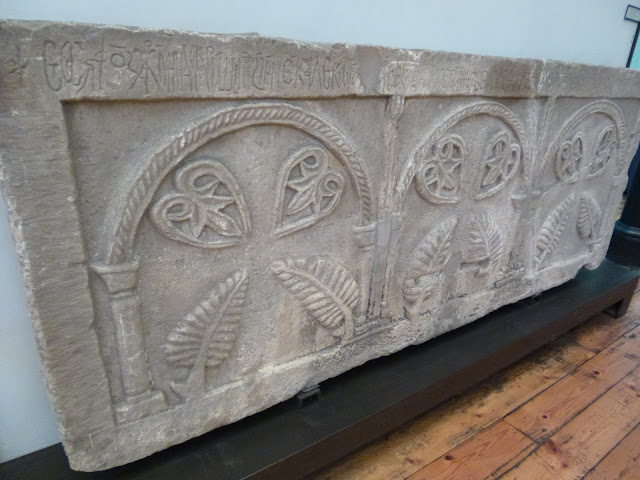Recently I've been in Sofia, the Capital of Bulgaria and I spent couple of days looking around and one of the most interesting places I found was the
National Archaeological Museum of Bulgaria (in Bulgarian: Национален археологически музей, pronounced as Natsionalen arheologicheski muzey) .
The museum was opened in 1905 and it occupies the building of the largest and oldest former Ottoman mosque in the city, Büyük camii ("Grand Mosque"), built around 1474 under Mehmed II. It has five exhibition halls: Central Hall, Prehistory, Middle Ages, Treasure, and a special temporary exhibition.
It is relatively small museum if compared with the British Museum for example, but nonetheless the quality of the exposition is top notch and inside can be seen some of the most exceptional archaeological findings in the World. The age of the exponates range from hundreds of thousands years old to medieval. This essentially means that there are objects created by people who may not have even been
H. sapiens and in any case we can get an idea how some of the first settles in Europe lived and how some of the most ancient Europeans looked like. Some of the more interesting things I've seen are the ancient human depictions, which show comparable to the 17-18 century level of craft and to some extent technology these people had 25-30 centuries ago. Other than that, there were several "Venus" statues, which due to the great similarity and posibly shared origin and inspiration may be used to reconstruct the position of the arms of the more famous "Venus de Milo".
 |
| In front of the museum can be seen several exponates on open air. It is called Lapidarium and in my personal opinion is not the best idea and I'd like to see the rationalisation behind such an idea. |
 |
| Between them can be seen detailed description and explanation in both Bulgarian and English languages |
 |
| Replica of the famous Madara horseman, depicting Horseman with 3 legged dog killing what is possibly a lion. |
 |
| Its often dated as late 7th century and its thought to depict some of the Bulgarian rulers from that time as Khan Tervel or Khan Omurtag. However it may happen that is much older and there is a lot mystery surrounding it. |
 |
| Examples of some of the ancient weapons that can be found often laying around in Bulgaria |
 |
| Ancient depictions of mythological beasts |
 |
| Many ceramic items like these can be found laying in the open fields around in Bulgaria |
 |
| Possible cast for copper or bronze axe |
 |
| Many of the items present recognisable style similar to the one in ancient Greece |
 |
| There can be seen various statues of semi-naked women possible part of the same type of depictions as Venus de Milo and as such can be used as help for reconstruction of the position of her arms |
 |
| Altar Screen Slab. Found on the floor of St. George Golemi Church in Mesambria (Nesebur). Marble, AD 13th to 14th Century. |
 |
| Peacocks perched on a fountin. Early Christian allegory: the peacocks stand for the immortal human souls, the fountin for the spring of life and the tree of life rises from it. Relief facing slabs. Red schist. AD 11th to 12th Century. Stara Zagora |
 |
| Some of these items resemble the ones from ancient Assyria and Babylon and some of the animals depicted are very strange looking and in the case with the crocodile looking beast, definitely not part of the fauna of the region |
 |
| Also very interestingly there were a lot of stone works, which looked to serve as some kind of family portrait, just like the now day photos. |
 |
| Many of the items show clear relation with their counterparts from Greece and Turkey |
 |
| Fortuna. Gigen (Oescus), Pleven region. Around the middle of 2nd Century |
 |
| Sgraffito ceramics |
 |
| Some of the oldest examples of the Cyrillic script can be found in this museum, in this case the tombstone of Ichirgu-boil Mostich, who lived during the reign of King Simeon the Great and King Pеter |
 |
| Glagolic and Cyrillic alphabets |
 |
| St. Theodore Stratilates |
 |
| Nominalia of the Bulgarian khans (Bulgarian: Именник на българските ханове), one of the most interesting written document found in Bulgaria |
 |
| Golden mask with weigh 673 grams, depicting the face of an adult man, with clearly portrayed individual features. It was cast and additionally processed by forging and chiselling. The portrait is dated to the 5th century BC and, so far, the only mask of this kind from this period in Thrace and the Mediterranean area. It said it is the mask of the Odrysian King Teres. |
 |
| Interesting example of one handed sword |
 |
| Depiction of Seuthes III (Ancient Greek: Σεύθης), ruler of the Odrysian kingdom of Thrace from c. 331 BC to c. 300 BC. |
 |
| The quality and detail are incredible. |
 |
| Poster from exposition in the Louvre |




































































No comments:
Post a Comment